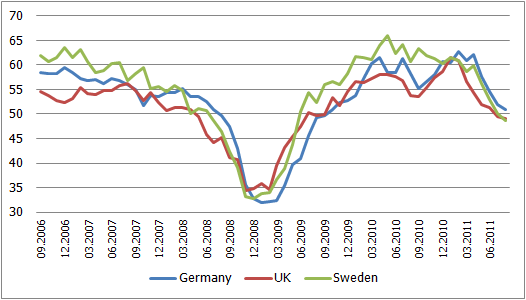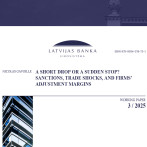Latvian exports continue to grow notably, yet global uncertainty also on the rise
In September both the exports and imports of goods continued to grow: the monthly rise in exports was 3.3% and the annual rise was 16.1%, whereas imports rose by 2.6% and 17.7% respectively.
Even though export growth has been quite stable, it is expected to slow down in the near future as a result of both weakening external demand and weakening pressure from global prices.
First, although Latvian exports to the problem countries of the euro area, i.e. Ireland, Italy, Greece, Portugal and Spain, are negligible and the financial systems of Latvia and these countries are not closely tied, developments in Europe can have a negative effect on the economic growth of trading partners that are important to us. For instance, the German and British banking sectors have financed the debts of the Greek public and private sectors, and these countries have an important place in the structure of our exports. A slowdown in the above economies would also weaken demand in other Latvian trading partners, as , for example, Germany, is the main trading partner to many markets important to us: Sweden, Poland, Denmark, Russia.
Second, prices of goods in the global market are already dropping in reaction to the risks of weakening demand. Even though some of Latvian groups of export goods previously grew both on account of volume and price increases, as the prices of these goods begin to drop in the global markets, export incomes can shrink.
Third, the Purchasing Managers Index in several of Latvia's main trading partners also points to the likelihood that external demand will dwindle (See Fig. 1).
In the main groups of Latvian export goods that account for 15.1%, 11.8% and 17.5% respectively of total Latvian exports in the first nine months, a month-on-month increase was observed in September: 25.2% for agricultural and food products, 0.7% for mechanisms and electronic equipment, 2.9% for wood pulp. In the exports of metals and their products that are important to Latvia, a sharp drop of 18.1% in September followed the rapid rises in July and August.
Goods imports have also grown at a stable pace, yet the increases are no cause for worries. First of all, about two thirds of total Latvian imports in the first nine months of the year was accounted for by capital goods and intermediate consumption goods which reflect growing manufacturing and investment. The increase in imports in the first nine months was significant year-on-year in the groups of raw materials and capital goods, e.g., 90.2% for mineral products, 44.4% for base metals and their products and 25.6% for mechanisms and electrical equipment. The excess of imports over exports thus serves to reflect the recovery of industry and investments. The increase of consumer goods imports is expected to be moderate, reflecting the slow recovery of household consumption.
Figure 1. Manufacturing PMI in some of Latvia's trading partners

Source: Reuters
Textual error
«… …»






